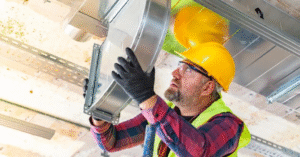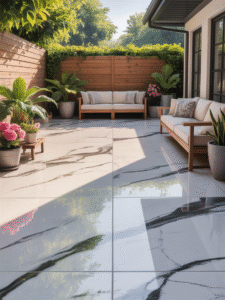Why Fabrication and Welding Are Essential for Safe, Durable Home Projects
Think of your home as a living organism. The timber is the muscle, the bricks are the skin, and the steel? That’s the skeleton holding it all together. Without strong bones, everything else wobbles. That’s where fabrication and welding step in, quietly, reliably, and often without homeowners realising how much they depend on them.
Whether it’s a carport in Castle Hill, a balcony railing in Balmain, or a staircase in Marrickville, welded steel shapes many of the home features we walk past daily. Safe homes don’t just happen. They’re built piece by piece, joint by joint, with sparks flying in the background.

What Fabrication and Welding Actually Mean
Let’s clear the air. Fabrication is the process of shaping, cutting, and assembling metal into usable forms, beams, brackets, frames, you name it. Welding is the method used to fuse those pieces together permanently.
Together, fabrication and welding create structural elements that can’t be undone with a few loose screws. They’re the difference between a railing that catches your fall and one that collapses under pressure.
A fabricated steel frame in a pergola, for example, doesn’t just hold up the roof sheets. It absorbs weight, resists wind, and lasts decades longer than timber in harsh Australian weather.
Why Your Home Needs Steel More Than You Think
Most people imagine welding belongs on a shipyard or at the back of an auto shop. But walk around your house and start looking closer.
- That gate swinging open every morning? Welded hinges.
- The steel lintel above your brick window? Fabricated to hold tonnes of weight.
- The stair balustrade keeping your kids safe? Welded joints, hidden under the paint.
Steel doesn’t bow with humidity, doesn’t swell with rain, and doesn’t invite termites in for lunch. Fabrication and welding keep your home standing tall when timber and screws alone wouldn’t.
Safety First! Literally.
Home safety isn’t always about locks and alarms. It’s about whether your balcony can handle twenty guests at a barbecue or if your carport roof can resist a storm.
Welded joints are stronger than the base metals themselves when done correctly. That’s no exaggeration. The process creates a permanent bond, removing weak points where bolts or nails could fail.
In Sydney’s Inner West, where heritage homes often combine modern extensions with old brickwork, welding plays a hidden role. Steel frames reinforce older structures so that your dream renovation doesn’t become tomorrow’s collapse story.
The Suburb Factor: Sydney’s Varied Challenges
Sydney isn’t one-size-fits-all, and neither are its building needs.
- Coastal Suburbs like Manly – Salt air corrodes steel faster. Here, welding and fabrication projects rely on galvanised or stainless steel to keep railings, gates, and frames rust-free.
- Leafy Areas like Castle Hill – Larger block sizes often mean bigger sheds, pergolas, and outdoor steel features. Thicker beams and custom fabrication step in.
- Inner West (Balmain, Marrickville, Newtown) – Heritage restrictions limit what can be changed on facades. Fabrication offers creative ways to strengthen existing structures without disturbing historic appearances.
This is where mentioning welding Sydney makes sense. The city’s geography demands different approaches to metalwork depending on postcode. A welder working in Bondi deals with different headaches than one in Parramatta.
Why DIY Welding Isn’t a Weekend Job
Here’s a quick story, One North Shore resident thought he could weld his own balcony railing. A buddy borrowed him a mini stick welder, and after a Saturday morning of flying sparks, he was pleased with what he had accomplished. Two weeks later, the railing snapped under slight stress. He had made “cold welds,” clean-looking joints which do not extend all the way through the metal.
Welding is merciless. The difference between a good joint and a fatal one can’t be detected by the naked eye. While most Aussies adore a good Do-It-Yourself job, some things are best left in the hands of people who live and breathe this kind of thing.
Fabrication: The Quiet Hero of Home Design
While welding is the adhesive, fabrication is the art. It transforms raw beams or sheets into something functional.
Custom-made steel stairs? Fabrication.
A steel frame for that quirky triangular extension in Newtown? Fabrication.
A fire-pit base that’s heat-resistant and won’t buckle? You bet.
The versatility is the strength of fabrication. In contrast to wood, which is trimmed to standard dimensions, steel can be bent, trimmed, and welded into almost any shape. With contemporary houses, this implies that radical designs no longer need to sacrifice safety.
Long-Term Payoffs of Doing It Right
Yes, steel fabrication and welding can cost more upfront than off-the-shelf timber or aluminium options. But here’s the thing: good steelwork pays you back.
- Durability: Done once, lasts decades.
- Safety: Protects your family without you thinking about it.
- Maintenance: Paint it occasionally and that’s about it.
- Value: Buyers notice solid structures. A shaky railing screams “cheap fix.”
Think of it like buying boots. The $40 pair might last a season, but the $200 pair sees you through years of wear and tear. Homes are no different.
The Hidden Beauty of Welds
The welds do not need to be attractive, but there is a sensitively beautiful quality to a tidy bead of metal. Some owners love the aesthetic of bare steel and visible welds, and it is a design element. Inner West warehouse conversions throughout Sydney have industrial interior styles that celebrate this.
A well-crafted railing or staircase is not just functional. It can be a decorative feature. Sometimes the joinery is so elegant that it seems to be sculpted rather than built.
Thinking Ahead: Steel in Future Projects
Whether sketching up ideas for a granny flat, looking at a pergola, or at last addressing that balcony extension, it’s worth considering steel early on.
Discuss with builders and designers where manufactured steel can enhance safety and minimize future headaches. Even if you don’t realize it, chances are the end plans will conceal welded supports in roofs, floors, or walls.
It’s the work that isn’t seen which holds it all above ground firm.
Wrapping Up
Fabrication and welding are the unsung heroes of Australian homes. They’re the ones in the carports protecting your ute, the balconies that support your family, and the staircases that get you to your bedroom half-asleep.
They don’t need a spotlight, but they deserve respect. Because without those sparks and steel, our homes would creak, sag, and crumble far sooner than we’d like.
So the next time you pass by a steel gate or rest against a railing, pay tribute to the welds that keep everything in place. They may not be noisy, but they ensure your house remains safe.









Post Comment